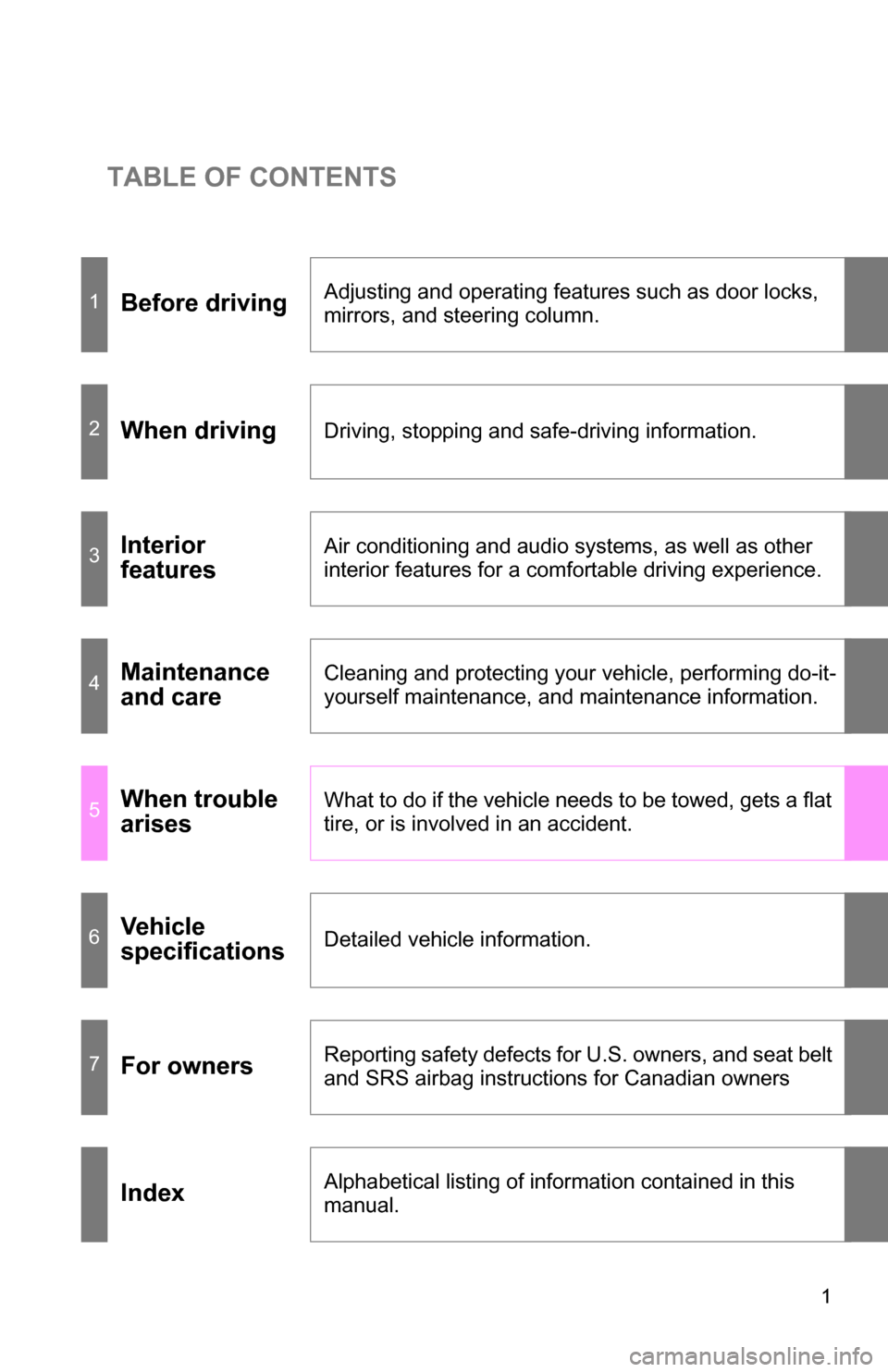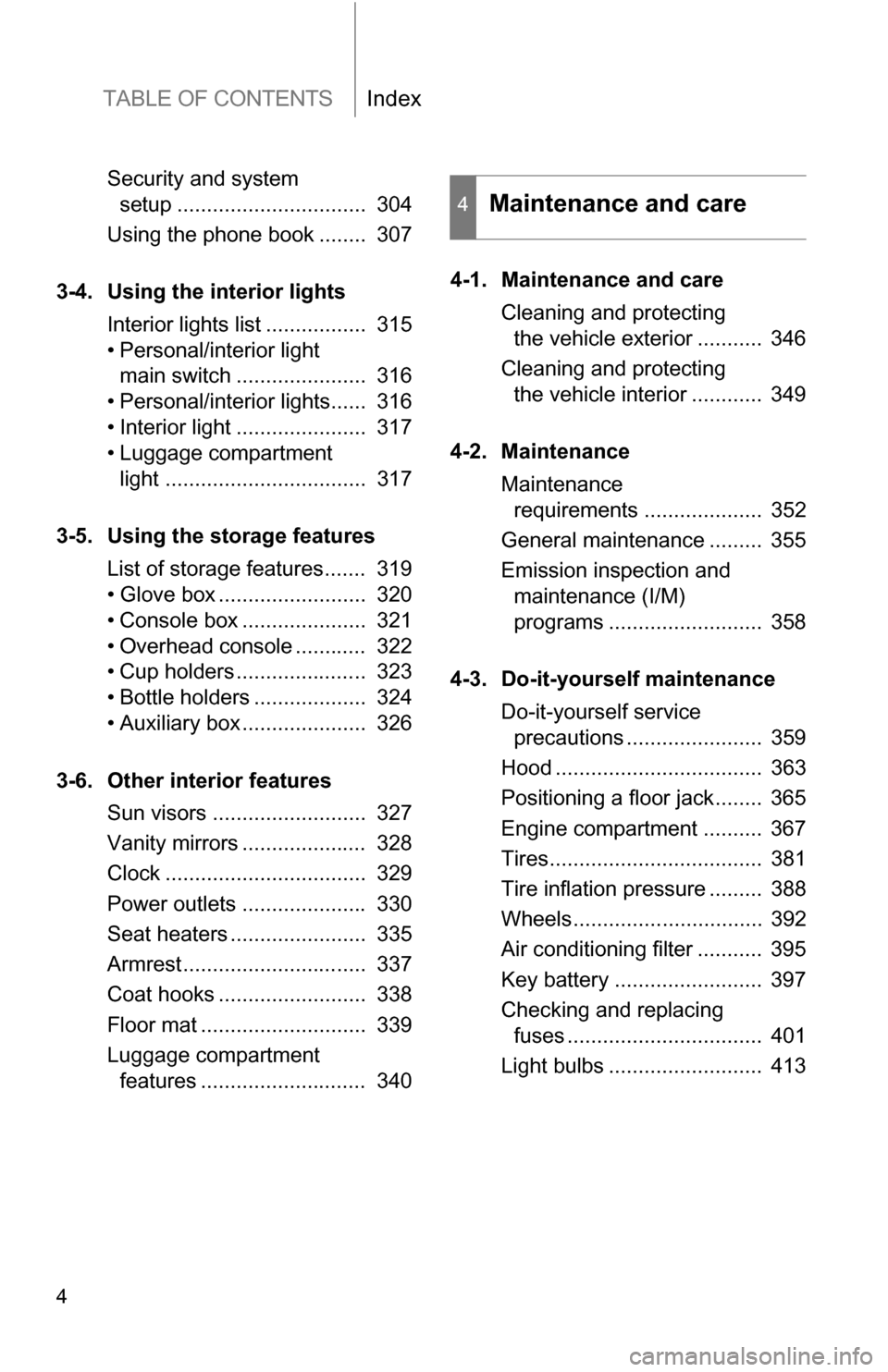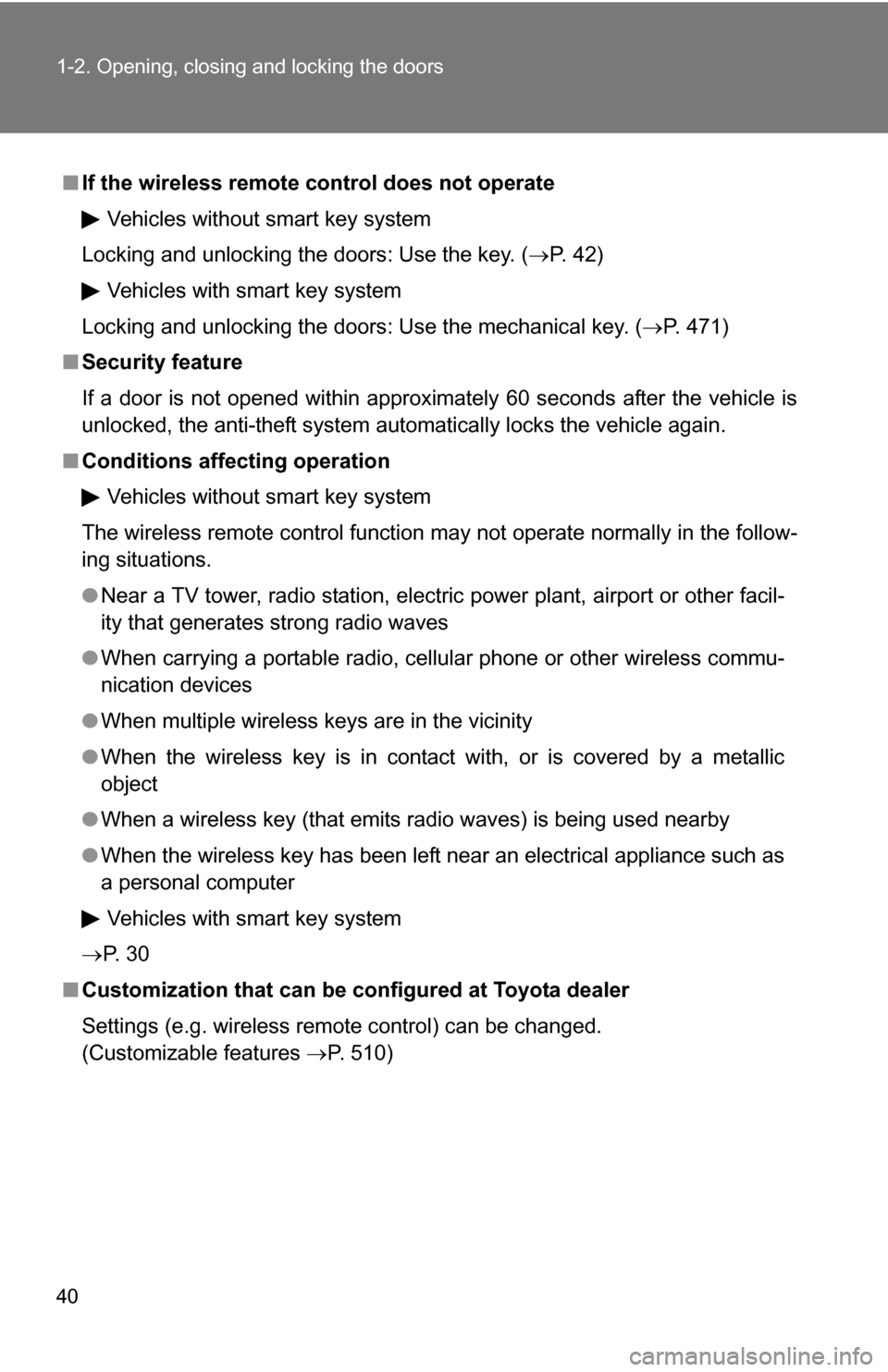air condition TOYOTA RAV4 2012 XA30 / 3.G Owners Manual
[x] Cancel search | Manufacturer: TOYOTA, Model Year: 2012, Model line: RAV4, Model: TOYOTA RAV4 2012 XA30 / 3.GPages: 544, PDF Size: 10.25 MB
Page 1 of 544

TABLE OF CONTENTS
1
1Before drivingAdjusting and operating features such as door locks,
mirrors, and steering column.
2When drivingDriving, stopping and safe-driving information.
3Interior
featuresAir conditioning and audio systems, as well as other
interior features for a comfortable driving experience.
4Maintenance
and careCleaning and protecting your vehicle, performing do-it-
yourself maintenance, and maintenance information.
5When trouble
arisesWhat to do if the vehicle needs to be towed, gets a flat
tire, or is involved in an accident.
6Vehicle
specificationsDetailed vehicle information.
7For ownersReporting safety defects for U.S. owners, and seat belt
and SRS airbag instructions for Canadian owners
IndexAlphabetical listing of information contained in this
manual.
Page 3 of 544

1
2
3
4
5
6
7
3
2-3. Operating the lights and wipers
Headlight switch .................. 167
Fog light switch ................... 171
Windshield wipers and washer .............................. 173
Rear window wiper and washer .............................. 177
2-4. Using other driving systems
Cruise control ...................... 179
Rear view monitor system .............................. 183
Driving assist systems ........ 191
Hill-start assist control ......... 198
Downhill assist control system .............................. 200
Four-wheel drive lock switch ................................ 203
2-5. Driving information Utility vehicle precautions ....................... 204
Cargo and luggage ............. 209
Vehicle load limits ............... 215
Winter driving tips ............... 217
Trailer towing ...................... 221
Dinghy towing ..................... 231 3-1. Using the air conditioning
system and defogger
Manual air conditioning system .............................. 234
Automatic air conditioning system .............................. 240
Rear window and outside rear view
mirror defoggers ............... 248
Windshield wiper de-icer .... 250
3-2. Using the audio system Audio system types ............ 251
Using the radio ................... 254
Using the CD player ........... 260
Playing back MP3 and WMA discs ....................... 267
Optimal use of the audio system .............................. 274
Using the AUX port............. 277
Using the steering wheel audio switches.................. 278
3-3. Using the hands-free phone system
(for cellular phone)
Hands-free phone system (for cellular phone)
features ............................ 281
Using the hands-free phone system
(for cellular phone) ........... 285
Making a phone call ........... 293
Setting a cellular phone ...... 299
3Interior features
Page 4 of 544

TABLE OF CONTENTSIndex
4
Security and system setup ................................ 304
Using the phone book ........ 307
3-4. Using the interior lights Interior lights list ................. 315
• Personal/interior light main switch ...................... 316
• Personal/interior lights...... 316
• Interior light ...................... 317
• Luggage compartment light .................................. 317
3-5. Using the storage features List of storage features....... 319
• Glove box ......................... 320
• Console box ..................... 321
• Overhead console ............ 322
• Cup holders ...................... 323
• Bottle holders ................... 324
• Auxiliary box ..................... 326
3-6. Other interior features Sun visors .......................... 327
Vanity mirrors ..................... 328
Clock .................................. 329
Power outlets ..................... 330
Seat heaters ....................... 335
Armrest............................... 337
Coat hooks ......................... 338
Floor mat ............................ 339
Luggage compartment features ............................ 340 4-1. Maintenance and care
Cleaning and protecting the vehicle exterior ........... 346
Cleaning and protecting the vehicle interior ............ 349
4-2. Maintenance Maintenance requirements .................... 352
General maintenance ......... 355
Emission inspection and maintenance (I/M)
programs .......................... 358
4-3. Do-it-yourself maintenance Do-it-yourself service precautions ....................... 359
Hood ................................... 363
Positioning a floor jack........ 365
Engine compartment .......... 367
Tires.................................... 381
Tire inflation pressure ......... 388
Wheels................................ 392
Air conditioning filter ........... 395
Key battery ......................... 397
Checking and replacing fuses ................................. 401
Light bulbs .......................... 413
4Maintenance and care
Page 15 of 544

15
With an automatic air conditioning system
With a manual air conditioning system
C
Air conditioning system P. 234
Rear window defogger switch
Outside rear view mirror defogger switch

P. 248
P. 248
Engine (ignition) switch
(with smart key system)
P. 145
Air conditioning system P. 240
Rear window and outside rear view mirror defogger switch P. 248
Security indicator P. 95
Security indicator P. 95
: If equipped
*: Refer to “Navigation System Owner’s Manual”.
Page 30 of 544

30 1-2. Opening, closing and locking the doors
â– Operation signals
A buzzer sounds and the emergency flashers flash to indicate that the doors
have been locked/unlocked. (Locked: Once; Unlocked: Twice)
â– Conditions affecting operation
The smart key system uses weak radio waves. In the following situations,
the communication between the electronic key and the vehicle may be
affected, preventing the smart key system and wireless remote control from
operating properly. (Ways of coping: ď‚®P. 471)
â—Ź When the electronic key battery is depleted
â—Ź Near a TV tower, electric power plant, gas station, radio station, large dis-
play, airport or other facility that generates strong radio waves or electri-
cal noise
â—Ź When carrying a portable radio, ce llular phone, cordless phone or other
wireless communication devices
â—Ź When the electronic key is in contact with, or is covered by a metallic
object
â—Ź When multiple electronic keys are in the vicinity
â—Ź When carrying or using the electronic key together with one or move of
the following devices that emit radio waves
• Another vehicle’s electronic key
• A wireless key that emits radio waves
• Personal computer
â—Ź If window tint with a metallic content or metallic objects is attached to the
rear window
â– Switching the door unlock function
It is possible to set which doors the entry function unlocks.
Turn the “ENGINE START STOP” switch OFF.
When the indicator on the key surface is turned off, push and hold or for approximately 5 seconds while pushing
on the key.
STEP 1
STEP 2
Page 40 of 544

40 1-2. Opening, closing and locking the doors
â– If the wireless remote control does not operate
Vehicles without smart key system
Locking and unlocking the doors: Use the key. ( ď‚®P. 42)
Vehicles with smart key system
Locking and unlocking the doors: Use the mechanical key. ( ď‚®P. 471)
â– Security feature
If a door is not opened within approximately 60 seconds after the vehicle is
unlocked, the anti-theft system automatically locks the vehicle again.
â– Conditions affecting operation
Vehicles without smart key system
The wireless remote control function may not operate normally in the follow-
ing situations.
â—Ź Near a TV tower, radio station, electr ic power plant, airport or other facil-
ity that generates strong radio waves
â—Ź When carrying a portable radio, cell ular phone or other wireless commu-
nication devices
â—Ź When multiple wireless keys are in the vicinity
â—Ź When the wireless key is in contact with, or is covered by a metallic
object
â—Ź When a wireless key (that emits radio waves) is being used nearby
â—Ź When the wireless key has been left near an electrical appliance such as
a personal computer
Vehicles with smart key system
ď‚®P. 3 0
â– Customization that can be co nfigured at Toyota dealer
Settings (e.g. wireless remote control) can be changed.
(Customizable features ď‚®P. 510)
Page 104 of 544

104 1-7. Safety information
â– SRS airbag deployment conditions
Front airbags
â—Ź The SRS front airbags will deploy in the event of an impact that exceeds
the set threshold level (the level of force corresponding to an approxi-
mately 12 - 18 mph [20 - 30 km/h] frontal collision with a fixed wall that
does not move or deform).
However, this threshold velocity will be considerably higher if the vehicle
strikes an object, such as a parked vehicle or sign pole, which can move or
deform on impact, or if the vehicle is involved in an underride collision (e.g.
a collision in which the front of the vehicle “underrides”, or goes under, the
bed of a truck, etc.).
â—Ź It is possible that in some collisions where the forward deceleration of the
vehicle is very close to the designed threshold level, the SRS front air-
bags and the seat belt pretensioners may not activate together.
â—Ź The SRS front passenger airbag will not activate if there is no passenger
sitting in the front passenger seat. However, the front passenger airbag
may deploy if luggage is put in the seat, or the seat belt is fastened, even
if the seat is unoccupied. ( ď‚®P. 113)
Side airbags and curtain shield airbags
â—Ź The SRS side airbags and SRS curtain shield airbags will deploy in the
event of an impact that exceeds the set threshold level (the level of force
corresponding to the impact force produced by an approximately 3300 lb.
[1500 kg] vehicle colliding with the vehicle cabin from a direction perpen-
dicular to the vehicle orientation at an approximate speed of 12 - 18 mph
[20 - 30 km/h]) or vehicle rollover.
â—Ź The SRS side airbag on the passenger seat will not activate if there is no
passenger sitting in the front passenger seat. However, the side airbag
on the passenger seat may deploy if luggage is put in the seat, or the
seat belt is fastened, even if the seat is unoccupied. ( ď‚®P. 113)
â—Ź The SRS curtain shield airbags are designed to inflate when the passen-
ger compartment is subjected to a severe impact from the side or vehicle
rollover.
Page 105 of 544

105
1-7. Safety information
1
Before driving
â–
Conditions under which the SRS airbags may deploy (inflate), other
than a collision
The SRS front airbags may also deploy if a serious impact occurs to the
underside of your vehicle. Some examples are shown in the illustration.
The SRS curtain shield airbags may also deploy under the situation shown
in the illustration.
â– Types of collisions that may not deploy the SRS front airbags
The SRS front airbags are generally not designed to inflate if the vehicle is
involved in a side or rear collision, if it rolls over, or if it is involved in a low-
speed frontal collision. But, whenever a collision of any type causes suffi-
cient forward deceleration of the vehicle, deployment of the SRS front air-
bags may occur.
â—Ź Hitting a curb, edge of pavement or
hard surface
â—Ź Falling into or jumping over a deep hole
â—Ź Landing hard or vehicle falling
â—ŹThe angle of vehicle tip-up is marginal.
â—Ź The vehicle skids and hits a curb stone.
â—ŹCollision from the side
â—Ź Collision from the rear
â—Ź Vehicle rollover
Page 113 of 544

113
1
1-7. Safety information
Before driving
Front passenger occupant classification system
Your vehicle is equipped with a front passenger occupant classifica-
tion system. This system detects the conditions of the front passen-
ger seat and activates or deactivates the devices for front passenger.
SRS warning light
Front passenger's seat belt reminder light
“AIR BAG OFF” indicator light
“AIR BAG ON” indicator light
Page 114 of 544

114 1-7. Safety information
Conditions and operation of the front passenger occupant
classification system
â– Adult*
1
â– Child*3 or child restraint system*4
Indicator/
warning light “AIR BAG ON” and “AIR BAG OFF”
indicator lights “AIR BAG
ON”
SRS warning light Off
Front passenger's seat belt reminder light
Flashing*2
Devices Front passenger airbag
Activated
Side airbag on the front passenger seat
Curtain shield airbag in the front passenger side
Front passenger's seat belt pretensioner
Indicator/
warning light “AIR BAG ON” and “AIR BAG OFF”
indicator lights “AIR BAG
OFF”*
5
SRS warning light Off
Front passenger's seat belt reminder light Flashing*
2
DevicesFront passenger airbag
Deactivated
Side airbag on the front passenger seat
Curtain shield airbag in the front passenger side Activated
Front passenger's seat belt pretensioner